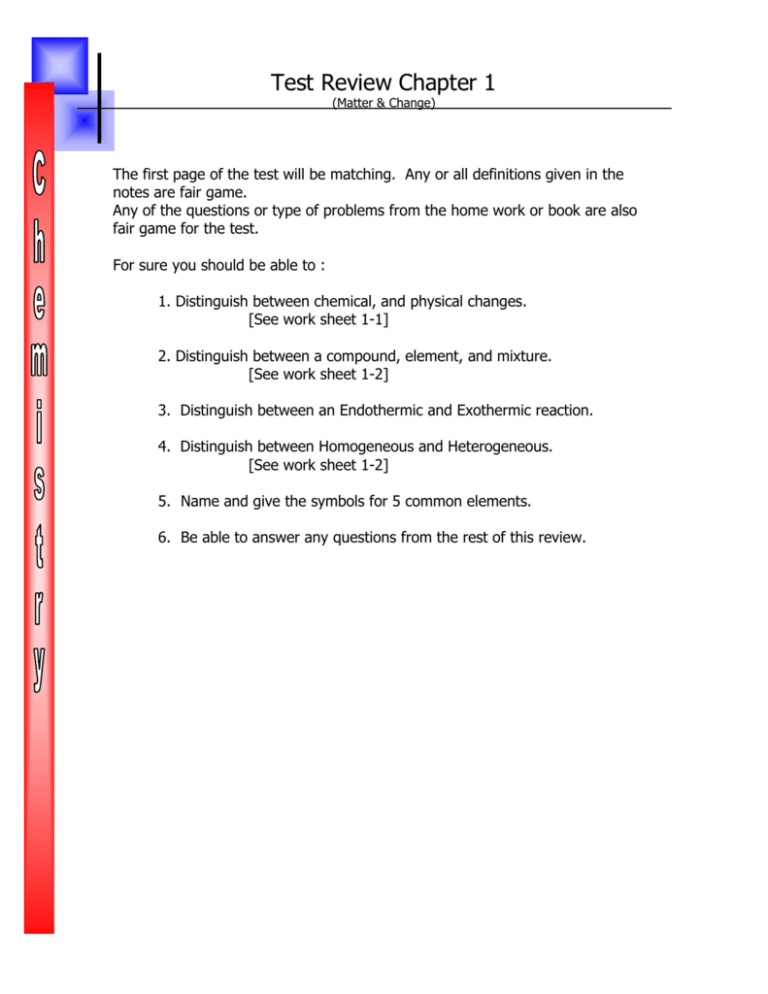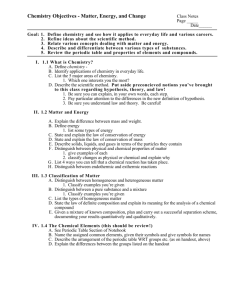Test Review Chapter 1
advertisement

Test Review Chapter 1 (Matter & Change) The first page of the test will be matching. Any or all definitions given in the notes are fair game. Any of the questions or type of problems from the home work or book are also fair game for the test. For sure you should be able to : 1. Distinguish between chemical, and physical changes. [See work sheet 1-1] 2. Distinguish between a compound, element, and mixture. [See work sheet 1-2] 3. Distinguish between an Endothermic and Exothermic reaction. 4. Distinguish between Homogeneous and Heterogeneous. [See work sheet 1-2] 5. Name and give the symbols for 5 common elements. 6. Be able to answer any questions from the rest of this review. 2 Multiple Choice Identify the letter of the choice that best completes the statement or answers the question. ____ ____ ____ ____ ____ ____ ____ ____ ____ ____ ____ ____ 1. The study of matter and changes in matter best describes the science of a. biology. c. microbiology. b. physics. d. chemistry. 2. Chemistry is a. a biological science. c. concerned mostly with living things. b. a physical science. d. the study of electricity. 3. The study of substances containing carbon is a. organic chemistry. c. nuclear chemistry. b. inorganic chemistry. d. analytical chemistry. 4. Basic research is a. the production and use of products that improve our quality of life. b. carried out to solve a problem. c. the identification of the components and composition of materials. d. carried out for the sake of increasing knowledge. 5. Applied research is a. the production and use of products that improve our quality of life. b. carried out to solve a problem. c. the use of mathematics and computers to design and predict the properties of new compounds. d. carried out for the sake of increasing knowledge. 6. Matter includes all of the following EXCEPT a. air. c. smoke. b. light. d. water vapor. 7. A physical property may be investigated by a. melting ice. c. allowing silver to tarnish. b. letting milk turn sour. d. burning wood. 8. Chemical properties a. include changes of state of a substance. b. include mass and color. c. include changes that alter the identity of a substance. d. can be observed without altering the identity of a substance. 9. Two features that distinguish matter are a. mass and velocity. c. mass and volume. b. weight and velocity. d. weight and volume. 10. One chemical property of matter is a. boiling point. c. reactivity. b. texture. d. density. 11. An example of an extensive physical property is a. mass. c. color. b. density. d. boiling point. 12. A chemical change occurs when a. dissolved minerals solidify to form a crystal. b. ethanol is purified through distillation. 3 ____ 13. ____ 14. ____ 15. ____ 16. ____ 17. ____ 18. ____ 19. c. salt deposits form from evaporated sea water. d. a leaf changes color. The melting of candle wax is classified as a physical change because it a. produces no new substances. b. transfers energy. c. absorbs heat. d. changes the chemical properties of wax. An example of a chemical change is a. sanding wood. c. milk going sour. b. melting ice. d. vaporizing gasoline. A physical change occurs when a a. peach spoils. c. bracelet turns your wrist green. b. copper bowl tarnishes. d. glue gun melts a glue stick. The state of matter in which a material has definite shape and definite volume is the a. liquid state. c. gaseous state. b. solid state. d. vaporous state. The state of matter in which a material has neither a definite shape nor a definite volume is the a. gaseous state. c. elemental state. b. liquid state. d. solid state. The state of matter in which a material has a definite volume but no definite shape is the a. gaseous state. c. frozen state. b. solid state. d. liquid state. A list of pure substances could include a. bread dough. c. vitamin C (ascorbic acid). b. vinegar (5% acetic acid). d. sea water. ____ 20. The homogeneous mixture in the illustration above is in container a. a. c. c. 4 b. b. ____ 21. The substances that are chemically bound a. the gases in the air. b. the elements that compose water. ____ 22. Physical means can be used to separate a. elements. b. pure substances. d. d. together are c. dust particles in air. d. substances in blood. c. mixtures. d. compounds. ____ 23. Which part of the illustration above shows the particles in a heterogeneous mixture? a. a c. c b. b d. d ____ 24. The most useful source of chemical information about the elements is a a. calculator. c. periodic table. b. table of metric equivalents. d. table of isotopes. ____ 25. A horizontal row of blocks in the periodic table is called a(n) a. group. c. family. b. period. d. octet. ____ 26. Elements in a group in the periodic table can be expected to have similar a. atomic masses. c. numbers of neutrons. b. atomic numbers. d. properties. ____ 27. A vertical column of blocks in the periodic table is called a(n) a. group. c. property. b. period. d. octet. ____ 28. The elements that border the zigzag line in the periodic table are a. inactive. c. metalloids. b. metals. d. nonmetals. ____ 29. Which is NOT a property of metals? a. malleability c. unreactivity b. ability to conduct heat and electricity d. tensile strength ____ 30. Which statement is NOT true of most metalloids? a. They are used in computers and calculators. b. They are semiconductors of electricity. c. They are generally unreactive. d. They have characteristics of both metals and nonmetals. 5 Short Answer 31. In one experiment, magnesium metal is melted. In a second experiment, magnesium metal is burned. Classify the change in each experiment as chemical or physical. Explain your reasoning. 32. Explain the difference between a pure substance and a homogeneous mixture. Use an example. 33. Xenon is generally unreactive. How is its low reactivity related to its position in the periodic table? Essay 34. Compare and contrast solids, liquids, and gases by explaining the behavior of their particles. Draw models to illustrate your answer. Element name Carbon Symbol C Element name Boron Calcium Ca Cadmium Symbol B Element name Sulfur Symbol Beryllium Be Silicon Si Cd Barium Ba Silver Ag Cobalt Co Bismuth Bi Sodium Na Copper Cu Bromine Br Strontium Sr S 35. Refer to the figure above to write a general rule for naming elements. There will be exceptions, such as sodium, to your rule. What might account for these exceptions? 36. What properties can be predicted from the position of a metallic element in the periodic table?









